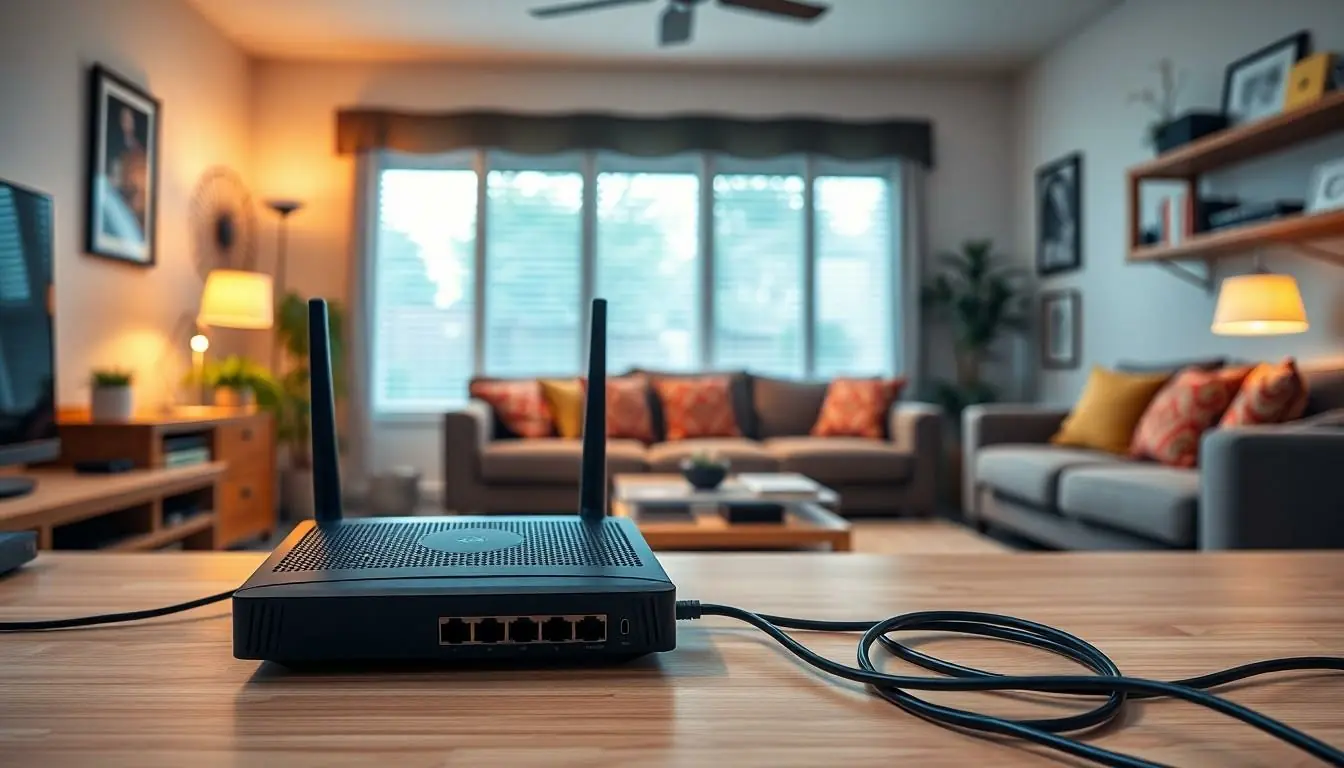Table of Contents
ToggleIn today’s world, a solid home network isn’t just a luxury; it’s a necessity. Imagine trying to stream your favorite show while your Wi-Fi stutters like a nervous first-time karaoke singer. Frustrating, right? A well-optimized home network keeps everyone connected, whether it’s for work, play, or binge-watching cat videos at 2 AM.
Understanding Networking Home
A reliable home network plays a crucial role in today’s connected world. It supports various devices and services within the household.
Definition of Networking Home
Networking home refers to the setup that allows multiple devices to connect to the internet and communicate with each other. Components often include routers, switches, and cables. These elements work together to create seamless connectivity. Home networks enable smartphones, computers, smart TVs, and other devices to access online content without interruptions.
Importance of Networking in Modern Homes
Networking holds significant importance for modern homes. It enhances productivity by supporting remote work, online learning, and smart home technology. High-quality connectivity allows seamless streaming of videos and gaming experiences. A reliable network connects various devices, ensuring smooth operation for entertainment and browsing. More families rely on high-speed internet for daily tasks, and connectivity challenges can lead to frustration.
Components of a Networking Home

A reliable home network comprises several essential components that work together for optimal performance. Understanding these components helps in creating a robust setup.
Routers and Modems
Routers serve as the central hub, directing internet traffic between devices. Modems connect the home network to the internet service provider. Together, they ensure steady connectivity for all online activities. Many modern devices combine both functions in one unit, simplifying the setup. Selecting a high-quality router enhances speeds and range, addressing issues like dead zones. Families often benefit from dual-band routers, which manage multiple devices efficiently.
Network Cables and Switches
Network cables, typically Ethernet cables, facilitate wired connections for fast data transfer. These cables connect devices directly to the router, providing consistent and reliable internet access. A switch expands the number of available wired connections within the network. Using a switch allows for multiple devices to link to the router simultaneously without sacrificing speed or performance. Properly categorized cables, such as Cat5e or Cat6, support higher bandwidth, accommodating the demands of smart homes.
Wireless Access Points
Wireless access points extend the reach of the home network, improving coverage in larger areas. They connect to the router, allowing devices to access the network wirelessly. In spacious homes, utilizing multiple access points ensures even distribution of Wi-Fi signals. This setup reduces congestion and improves streaming and gaming quality. Strategically placing access points helps eliminate dead zones, ensuring seamless connectivity throughout the home.
Setting Up a Networking Home
Establishing a well-functioning home network requires thoughtful planning and the right tools. Each component must work seamlessly together to meet digital needs.
Planning Your Home Network
Begin by assessing internet usage across all devices. Consider the number of devices connecting simultaneously, such as laptops, smartphones, and smart home equipment. Identify areas needing strong connectivity to minimize dead zones. Sketch a rough layout of the home to pinpoint the optimal router placement. This helps ensure even wireless coverage. Determine whether wired connections are preferable for specific devices, such as gaming consoles and streaming devices that benefit from stability.
Essential Tools for Installation
Gather necessary tools, including a drill, screwdriver, and cable clips. Using a drill provides ease in securing devices, while a screwdriver helps assemble hardware. Network cables must match the requirements of modern routers for reliable connections. Opt for Ethernet cables for wired setups to enhance speed. Powerline adapters may also be useful for extending the network without running long cables. Installing access points or range extenders can significantly boost Wi-Fi coverage in larger homes, ensuring consistent connectivity in every room.
Common Networking Home Issues
Home networks often face various issues that disrupt connectivity and security, impacting daily online activities.
Connectivity Problems
Connectivity problems frequently arise, hindering users from enjoying seamless internet experiences. Signal interference from walls and electronic devices can create dead zones, affecting Wi-Fi strength. High-bandwidth activities like streaming and gaming can become frustrating with slow speeds or dropped connections. Network congestion occurs when too many devices connect simultaneously, leading to significant slowdowns. Regularly checking for firmware updates on routers can resolve many underlying issues. Utilizing Ethernet cables improves stability and speed for essential devices. Observing closely the placement of networking equipment helps maximize coverage throughout the home.
Security Concerns
Security concerns pose significant risks to home networks, making robust protections necessary. Unsecured networks leave personal information vulnerable to unauthorized access. Configuring strong passwords for both routers and devices prevents unwanted users from joining the network. Updating software regularly protects against emerging threats. Utilizing guest networks allows visitors internet access without compromising the main network. Enabling firewalls adds a critical layer of defense against cyber threats. Employing network monitoring tools can help identify suspicious activity in real-time, ensuring the network remains secure.
Enhancing Your Networking Home
Optimizing a home network enhances connectivity and performance for all devices. Consider integrating advanced solutions like mesh networks and smart home technology.
Mesh Networks
Mesh networks distribute Wi-Fi signals evenly across a home, eliminating dead zones. Multiple nodes communicate with one another, ensuring robust coverage throughout larger spaces. Devices connect seamlessly to the closest node, enhancing overall speed and reducing latency. Mesh systems adapt to home layouts, making them ideal for challenging environments. Choosing a mesh network can significantly improve streaming quality and online gaming experiences. Current models support numerous devices without a drop in performance, making them suitable for modern households.
Smart Home Integration
Integrating smart home devices increases efficiency and convenience. A well-established network is vital for devices like smart thermostats, cameras, and lights to operate optimally. These devices rely on constant connectivity for effective communication. Central hubs can unify controls for various gadgets, simplifying user interaction. Prioritizing a strong Wi-Fi signal ensures real-time responsiveness from smart appliances. Advanced protocols like Zigbee and Z-Wave enable devices to connect without overloading Wi-Fi. Establishing a reliable network also enhances the security of connected devices, guarding against potential vulnerabilities.
A strong home network isn’t just a luxury; it’s a necessity in today’s tech-driven world. With the increasing reliance on high-speed internet for work and entertainment, investing time and resources into optimizing a home network pays off. Proper setup and maintenance can significantly enhance connectivity, reduce frustrations, and support a seamless digital experience.
By understanding the essential components and addressing common issues, anyone can create a reliable network that meets their needs. As technology continues to evolve, staying informed about advancements like mesh networks and smart home integrations ensures that a home network remains efficient and secure. Embracing these solutions can lead to a more connected and enjoyable living environment.



